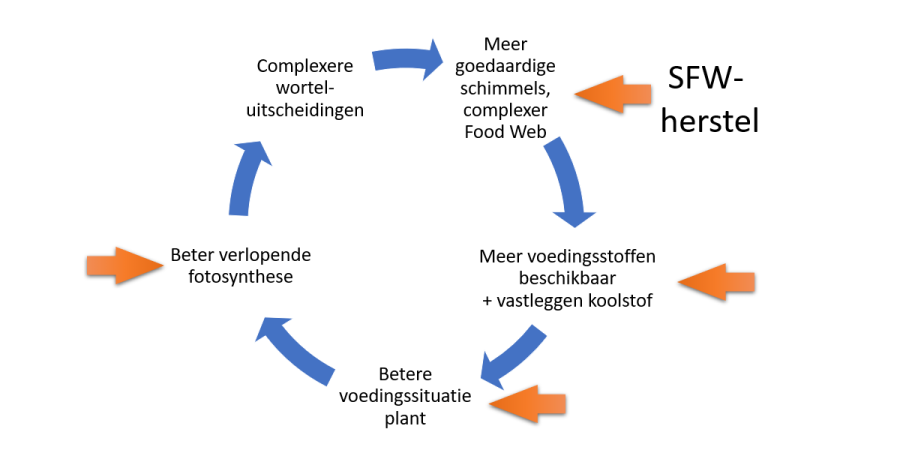
Regenerative agriculture improves soil life and plant health
The goal is clear: everyone is looking for optimal plant growth. In regenerative agriculture, there are different concepts of how to achieve this. They all affect the cycle of more diverse soil life (including more beneficial fungi) - better nutrient availability/more carbon sequestration - better plant nutritional status - better photosynthesis - more complex root secretions.
With the Soil Food Web approach, we intervene to increase the complexity of the Soil Food Web. We increase the amount of fungi, protozoa and beneficial nematodes. All of these are usually very low or even absent. The numbers of bacteria mostly rather on the high side. In this case, we increase the biodiversity of aerobic bacteria but reduce their numbers. The aim is to optimise the fungal-bacterial ratio and their predators for the desired plants. Predators in this case are those who eat bacteria and fungi. A more complex soil food web makes more nutrients available to the plant and stores more carbon in the soil.
The plant then gets better nutrition - no peaks and lows as when using fertilizer - even precision farming - but a continuous flow of nutrients, actually a kind of "just in time delivery".
A better nutritional situation of the plant leads to a better photosynthesis - the plant has more energy available. As a result, more complex carbon compounds can be produced. These in turn end up in the root exudates.
The result is a more complex and complete Soil Food Web because the plant also provides food for a greater diversity of fungi. In fact, there are fungi that - like bacteria - ah, and humans - love simple sugars. Other fungi prefer somewhat more complex compounds than sugars. Primarily, these are carbohydrates and proteins. Still others do just fine on fatty acids. And then there are those that like extremely complex compounds most, produced by the excretions - waste products - of other fungi. Humic acid is one example of this. At some point, this becomes a system with self-reinforcing positive feedback.
The difference between the Soil Food Web method and many other methods in regenerative agriculture is that in the Soil Food Web method, we are committed to growing micro-organisms in compost. Preferably from locally available materials. Local materials are the source of local microbes. We collect and multiply them in a hot composting process or worm compost. Going forward, we inoculate the microorganisms into the soil and repeat this several times.
In many other methods of regenerative agriculture, it is hoped that at some point the organisms will recover on their own by adding fungal nutrition to the soil, optimising the plant's nutrient supply or stimulating photosynthesis through foliar sprays.
With the Soil Food Web method, in the first year we invest heavily into building the right populations of bacteria, fungi, protozoa and nematodes. In this process of raising the populations of micro-organisms, the living conditions of the microbes in the soil improve. Lots of micro-organisms in the soil attract the larger players of the Soil Food Web from the environment. Over time, the plant itself can grow and maintain the microbes it desires. Then you only need to intervene when the Soil Food Web becomes unbalanced due to external conditions. On most soils, you can thus enjoy the services of the Soil Food Web within a short frame of time.








